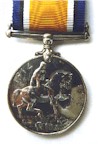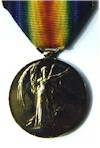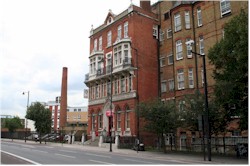


Ernest James Foulston's WW1 Army Records, downloaded from Ancestry.co.uk
This documents my interpretation of these badly damaged and highly cryptic documents. I have added further notes and pictures gleaned from general internet researches.
(1) Medal Card
R.G.A = Royal Garrison Artillery
Victory medal
British medal
SWB
The Silver War Badge (SWB), sometimes erroneously called the Silver Wound Badge, was authorised in September 1916 and takes the form of a circular badge with the legend "For King and Empire-Services Rendered" surrounding the George V cypher. The badge was awarded to all of those military personnel who were discharged as a result of sickness or wounds contracted or received during the war, either at home or overseas.
 |
 |
 |
| British War Medal | Victory Medal | Silver War Badge |
(2) Short Service Enlistment Attestation.
The form dated 5.6.16 but date stamped 1 DEC 1915 states:
| No 90917 | Foulston EJ |
| Corps | Royal Garrison Artillery |
| Address | 14 Harcombe Rd |
| S.Newington | |
| Trade | Postman |
| Age | 30 years |
(3) Descriptive Report On Enlistment
This form has various details including:
| next-of-kin | Kate Foulston | |
| Address | 14 Harcombe Rd | |
| S.Newington | ||
| Relationship | Wife | |
| Particulars as to Marriage | Name of woman to whom married | Kate Brown |
| Place and date of marriage | Parish Church West Hackney 8/10/1905 |
|
| Particulars as to children | Ernest Robert James | 10/3/1906 |
| Ivy Kate | 10/2/1912 | |
| Sidney Charles | 25/6/1914 |
Note the address has been crossed through and 78 Dumont Rd pencilled below indicating that Kate moved house whilst Ernest was at war.
Note that our direct ancestor Sydney's name has been unusually spelled as Sidney. He was only about 18 months old when his father went to war.
The form has a section marked MILITARY HISTORY SHEET
| 3. Wounded | Cryptic text difficult to decipher |
| 5. Medals | B.W. and V Medal |
B.W. almost certainly means British War Medal.
V. almost certainly means Victory Medal.
The whereabouts of Ernest's actual medals is unknown.
(4) Statement of Services
A mixed collection of hand-written and stamped data such as.
| Attested | 1/12/15 |
| Mobilized | 2/12/15 |
| Posted | 3 JUN 1916 |
| Discharged - no longer physically fit for War Service | |
| Date | 27.9.19 |
| Place | Dover |
| Home Address | 78 Dumont Rd Stoke Newington |
| Character | V. Good |
| Disability | G.S.W caused amputation of Right Leg G.S.W left ankle |
| Caused by Service | Yes |
| difficult to decipher | 1.10.19 |
| Statement of Services | |||
| From | To | Years | Days |
| 1.12.15 | 20.1.17 | 1 | 51 |
| 21.1.17 | 28.1.18 | 1 | 8 |
| 29.1.18 | 12.2.18 | 15 | |
| 18.2.18 | 31.10.18 | 261 | |
| 1.11.18 | 27.9.19 | 331 | |
| 3 | 301 | ||
Note. Almost four years service. Also discharge date of 27.9.1919 is approx 10 months after the end of the war.
(5) R.G.A. Record Office (Dover), medal receipt card dated 20.9.1921.
Receipt signed by Ernest for his B.W. and V medals (British War and Victory). R.G.A = Royal Garrison Artlillery
| Regtl. No | 90917 |
| Rank | Gunner |
| Signature | E.J.Foulston |
| Unit | 1/1 Highland (Fife) |
| Date | 21.9.1921 |
(6) Damaged form difficult to interpret.
| W.O. Cas List | Wounded Sht adm Metropolitan | Initials? |
| Reference no? | H. Kingsland Rd. N. | date (possibly 26-1-19) |
| 4-1-19 |
My interpretation is 'War Office Casualty List', Wounded, shot? admitted to the Metropolitan H.(ospital) Kingsland Road N. (London i.e. Hackney) at a date, possibly 4-1-1919.
 |
| Metropolitan Hospital, Kingsland Rd. |
| Office | ??? to Queen |
| Mary's Convalescent | |
| Hospital Roehampton | |
| 31-7-19 |
Queen Mary's Hospital, Roehampton was founded in 1915 initially as a military convalescence
hospital for servicemen who had lost
limbs in World War 1. It soon became renowned as a centre for rehabilitation of amputees.
In the 1920s plastic surgery, burns and maxillofacial surgery were added and in World War 2 it
became a specialist centre for the treatment of tropical diseases, especially for
Far East Prisoners of War. In the 1960s it became part of the NHS as a district general
hospital while retaining its specialist services. In 1998 it became a community hospital.
| RP 11-8-19 | Cannot understand writing | Inf always good |
| 23-8-10 |
| Man | Asks that marks and scars | Reference? |
| may be amended | ammended and retd | |
| 3/10/19 | 7/10/19 |
(7) Inside Sheet (For Original Attestation)
| No | 90917 | Name | Foulston EJ |
| From Whom | Purport and Date | Action |
| Wife | Heard that her husband | reference? |
| was ? both legs 23rd inst | sent 31.10.18 | |
| asks for news | signature | |
| W.O Cas List | G.S.W. Chest Ankle ? | |
| Reference? | Leg. Right Frac Sev | N of Kin |
| Adm 5 Gen Hos Rouen | informed | |
| 24.10.18 | 6.11.18 | |
| W.O Cas List | Wounded. Adm 3 Western | signature |
| reference? | Gen H. ? 1.11.18 | 14.11.18 |
The Base Hospital was part of the casualty evacuation chain, further back from the front line than the Casualty Clearing Stations. They were manned by troops of the Royal Army Medical Corps, with attached Royal Engineers and men of the Army Service Corps. In the theatre of war in France and Flanders, the British hospitals were generally located near the coast. They needed to be close to a railway line, in order for casualties to arrive (although some also came by canal barge); they also needed to be near a port where men could be evacuated for longer-term treatment in Britain. There were two types, known as Stationary and General Hospitals. They were large facilities, often centred on some pre-war buildings such as seaside hotels. The hospitals grew hugely in number and scale throughout the war. Most of the hospitals moved very rarely until the larger movements of the armies in 1918. Some hospitals moved into the Rhine bridgehead in Germany and many were operating in France well into 1919. Most hospitals were assisted by voluntary organisations, most notably the British Red Cross
(8) Ministry of Pensions
|
SIR I am directed by the Minister of Pensions to inform you of the undermentioned decision in the case of a man whose discharge documents have been recently received with the view to having the claim to pension considered. I am, Sir, Your obedient Servant (unreadable signature) Director, Soldiers Awards Branch. |
This document is covered in cryptic references, initials and date stamps giving dates of 26th, 27th and 29th Oct 1919
| Rank (for pension) | Gunner | regimental No | 90917 | |||
| Name (surname first) | FOULSTON Ernest James | |||||
| Regiment or Corps | RGA 1/1 High ?? | |||||
| Date of Discharge | 27.9.19 | Age on Discharge | 34 | Marital Status | Married | |
| Address on Discharge | 78 Dumont Rd. Stoke Newington N.16 | |||||
| Damaged unreadable | Ampt Rt Leg | |||||
| State whether attributable | Attrb | |||||
| aggrevated, or | ||||||
| non-attributable | ||||||
The remainder of the form is too damaged to read except the bottom right hand corner.
| Nature of Award | Condl |
Condl presumably means 'conditional', but upon what?
(9) Company Conduct Sheet ?
Its difficult to make any sense of this document.
| Offence | Name of Witnesses |
| Certified No Entry | |
| Dover | For O.C. i/c R.G.A. Record |
| 30.9.19 |